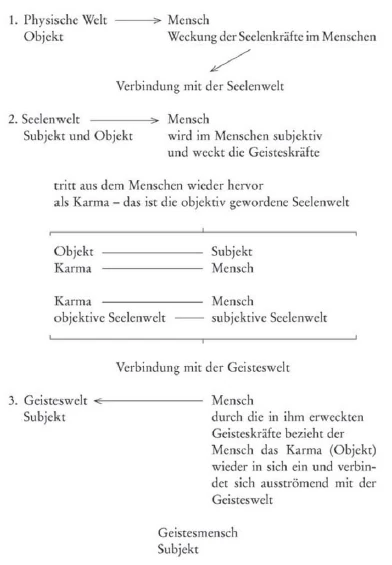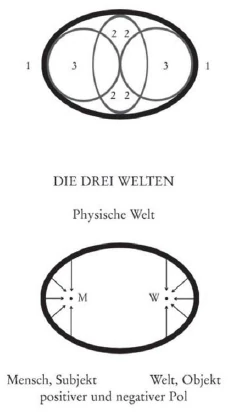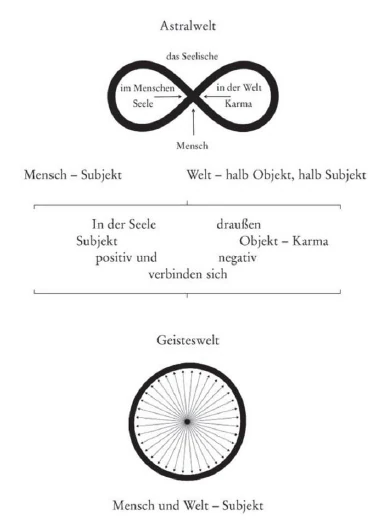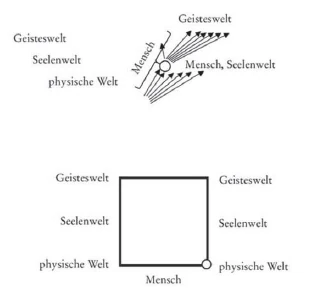Notes from Mathilde Scholl 1904–1906
GA 91
30 September 1906, Landin
Translated by Steiner Online Library
35. The Three Worlds
In the physical world, space is immobile; in order to perceive something in space, we must approach the things in space; we must move ourselves through space towards the things. Space is what contains the physical world. Time enables us to move towards the things in space. Time is what stands for us in the physical in place of the mobility of space. This movement in time through space is represented by the ellipse.

In the astral world, space itself is mobile; physical locomotion is not necessary there; the astral world perceives the human being in all its parts from the point where he is at the moment, no matter where. There he does not need time to move from one part of the astral world to another. He lives there in time, just as he lives here in space. Time is his essential environment there, not space. And everything in the astral space moves through him. This is represented by the lemniscate.

Just as time moves and advances in the physical, so space itself moves and advances in the astral. Space, which is immobile in the physical, is an image of man, who is firmly rooted in the physical. When man, as firmly established in the physical, has learned to stand firm in the astral, then the time has come when he can stand firmly in the astral and let the world pass through him. There he must have the same firmness as space in the physical in order to know his way around in the astral world. For the movement of another being or object can only be judged correctly if one is firmly established oneself. Therefore, complete soul balance is necessary to explore the astral realm, because otherwise one would always be subject to deception.
In the spiritual world, the human being is at the center of a radiant world that radiates into him from all sides, a resounding world that flows together in him in its vibrations. This is represented by the circle, where the human being stands in the middle.

Wherever one is in the spiritual world, one is at the center of it, and all around it is spread out. There is no need for space or time because the human being has absorbed space and time within himself and has united within himself all the effects of space and time. There he encompasses with his spirit everything that is there, by sending out the spirit from the point where he is at that moment, grasping things with the spirit and drawing them towards him.
In the physical world, the human being moves through space in time. In the astral world, space moves through time in the human being. In the spiritual world, time moves through space in the human being, where he has space within him, into which time flows and from which it flows out again.

The human being is placed in space through the physical organism. His upright spine, the entire skeleton with the limbs represents standing in space, and his mobility gives him the possibility of moving in time through space. The movement of the astral space, the soul world within him through time, corresponds to his blood circulation.
His breathing in and out corresponds to the connection of his spirit with the spiritual world. He can connect the spirit outside with his spirit within without space and time, just as he breathes out and in the air. Space and time enter into him with the spirit, or he connects with space and time through his spirit. In the physical, space and time are outside of him; in the astral, he connects with time; in the spiritual, he connects with space and time. While in the physical, space rests outside of him, and in the astral, space moves through him, in the spiritual, space rests within him.
Thus, in man, that which is solid is that which makes him dependent on space and time, that which connects him to the physical world. That which is liquid is that which connects him to the soul world, that which makes him independent of space. That which is aerial is that which connects him to the spiritual world, that which makes him independent of time. We can only perceive with our senses in space; we can only perceive with our soul in time; we can perceive spiritually without space and time. There, space and time have become forces within us. The solid, the physical world, approaches man from the outside; it stands opposite him; it is different from himself and remains different; the liquid - the astral world - flows through him and flows out again; the other connects with him; the air-shaped — the spiritual world — flows into him and becomes him; just as with every breath the air flows into us and the exhaled air contains something of our being and carries it out.
While the physical world is objective to man, his relationship to the spiritual world is purely subjective. The connection with the astral world is both objective and subjective. As long as the astral world passes through him, it is his property; he lives in it subjectively; but what he adds from his own soul to the astral comes out of him again with the current of the astral and then confronts him as an objective. This is his karma, which, when it confronts him as an overall picture, forms the Guardian of the Threshold. Karma is the soul-life of man that has become objective. To overcome this karma, man must reunite with it; he must re-incorporate the soul-life that has become objective in such a way that he becomes one with it, that it is reborn subjectively in him out of the spirit. When he allows karma to arise subjectively out of his spirit, then karma becomes a spiritual power in him. Thus we have to look at man as a spiritual, living laboratory that transforms the forces of the world.
Man never completely connects with the physical world; he connects with the soul world, but then it comes out of him again; he connects with the spiritual world, and it remains in him.
He moves through the physical world, gathering experiences in space with the help of time. These experiences awaken soul forces in him. Through this, he enters into contact with the soul world. The soul world now passes through his soul with its images and emerges through him, transformed, as his karma. His karma is what he has worked from his being into the soul world. But the soul world that passes through him has also created something new within him; it has awakened his spiritual powers. With his spiritual powers, he now draws the karma, his soul world that has become objective, back into his inner being and now works on it in his inner being with his spiritual powers and sends it out again into the world, transformed as spirit.
The path of development is therefore this:

First moving around the two focal points of the ellipse of physical life, then human life flows through the soul through the center between the two focal points of a lemniscate and then flows in the spirit from the center to the periphery of the circle.


Through his karma, which is transformed in the soul, the person connects with the spiritual world. The effect that arises from the union of the negative and positive poles, of object and subject, is radiance, light.

The whole physical world is there for the purpose of gaining experience, of awakening the soul forces; the soul world is there to develop the powers of the human being; the activated powers of the human soul work out its inner subjective being as an outer objective, as karma; this karma is as good as the human being is himself as the inner being of his soul; he must reconnect with this karma. In the spiritual world, he expresses what he has gained in new powers through the conscious, self-willed connection with his karma. Just as the breathing of physical impressions in the human soul awakens forces in the soul, so does the taking up of karma in the human spirit awaken forces in the spiritual.
Man has left the physical world behind him in his physical development as a stage in his physical ascent; it becomes a teacher for his soul; the soul world, karma, man has left behind him in his soul development as a stage in his spiritual ascent; it acts as a teacher for the spirit, for its enrichment and growth. The path to spiritualization in humanity goes through the soul. When a person learns to consciously carry out this process of development, then he consumes his karma as quickly as it arises, and he no longer has personal karma.
The development of humanity is an alchemy that transforms physical impressions into spiritual powers. Man can learn to shorten the process of development, to subordinate it to his will. He who has reached the degree of mastery can immediately consciously transform everything he perceives through the senses into spiritual power in his soul. The path of the student is the gradual development of the soul to this level, where he consciously learns to perform the spiritual alchemy. When he has achieved the transformation of his own karma into spiritual power, then he can also reach the stage where he no longer accumulates karma because he is so stable in the spiritual that he immediately transforms the physical into the spiritual through his soul. The power that he would otherwise have had to use to transform his own karma, he can then use to transform the karma of the world. One who has transformed the karma of the world into spiritual world powers in such a way that all of humanity owes him the power for their ascent is Christ. And in every single person, it is also the power of Christ, love, that transforms his karma into spiritual power. Love is the soul power that transforms karma into knowledge, into wisdom, into spiritual power.
Man must learn more and more to shorten the world process of transforming everything physical into spiritual through the power of his soul, love. Love is the bond that entwines and connects the physical and the spiritual. Thus, on the one hand, there is the physical world and, on the other, the spiritual world, with the human being in the middle and in both worlds at the same time. The soul world is the arena in which the human being transforms the forces of the physical world into spiritual ones.


35. Die Drei Welten
In der physischen Welt ist der Raum unbeweglich; damit wir etwas im Raume wahrnehmen können, müssen wir an die Dinge im Raume herangehen; wir müssen uns selbst zu den Dingen hin bewegen durch den Raum. Der Raum ist das, was die physische Welt enthält. Dass wir uns zu den Dingen im Raume hin bewegen können, das ermöglicht uns die Zeit. Die Zeit ist das, was für uns im Physischen an Stelle der Beweglichkeit des Raumes steht. Dieses Bewegen in der Zeit durch den Raum wird dargestellt durch die Ellipse.

In der Astralwelt ist der Raum selbst beweglich; da ist die physische Fortbewegung nicht notwendig; den Menschen kann die Astralwelt wahrnehmen in all ihren Teilen von dem Punkte aus, wo er gerade ist, gleichviel wo. Dort braucht er nicht die Zeit, um sich von einem Teil der Astralwelt zum anderen zu bewegen. Er lebt dort selbst so in der Zeit, wie er hier im Raume lebt. Die Zeit ist dort seine wesentliche Umgebung, nicht der Raum. Und alles, was im Astralraume ist, bewegt sich selbst durch ihn hindurch. Dies wird durch die Lemniskate dargestellt.

So wie im Physischen die Zeit sich bewegt und vorwärts schreitet, so bewegt sich im Astralen der Raum selbst und schreitet vorwärts. Der im Physischen unbewegliche Raum ist ein Bild des im Physischen festen Fuß fassenden Menschen. Wenn der Mensch so, wie er im Physischen fest steht, gelernt hat, im Astralen fest zu stehen, dann ist die Zeit gekommen, wo er im Astralen auch fest stehen kann, um die Welt durch sich hindurchgehen zu lassen. Dort muss er selbst solche Festigkeit haben wie im Physischen der Raum, um sich in der Astralwelt auszukennen. Denn die Bewegung eines anderen Wesens oder Gegenstandes kann man nur richtig beurteilen, wenn man selbst fest steht. Darum ist das vollständige Seelengleichgewicht notwendig, um den Astralraum zu erforschen, weil man sonst immer Täuschungen unterworfen sein würde.
In der Geisteswelt ist der Mensch im Mittelpunkt einer strahlenden Welt, die von allen Seiten in ihn einstrahlt, einer tönenden Welt, die in ihren Schwingungen in ihm zusammenströmt. Das wird dargestellt durch den Kreis, wo der Mensch in der Mitte steht.

Wo man auch immer ist in der geistigen Welt, da ist man im Mittelpunkt derselben, und ringsherum liegt sie ausgebreitet. Da ist weder Raum noch Zeit notwendig, weil der Mensch dort Raum und Zeit in sich aufgenommen hat und alle Wirkungen des Raumes und der Zeit in sich vereinigt hat. Er umfasst dort mit seinem Geiste alles, was da ist, indem er selbst von dem Punkte aus, wo er gerade sich befindet, den Geist aussendet, mit dem Geiste die Dinge erfasst und zu sich heranholt.
In der physischen Welt bewegt sich der Mensch selbst in der Zeit durch den Raum. In der Astralwelt bewegt sich der Raum in der Zeit durch den Menschen. In der Geisteswelt bewegt sich die Zeit durch den Raum im Menschen, da hat er in sich den Raum, in den die Zeit einströmt, und aus dem sie wieder ausströmt.

Durch den physischen Organismus ist der Mensch in den Raum gestellt. Sein aufrechtes Rückgrat, das ganze Knochengerüst mit den Gliedern stellt das Stehen im Raume dar, und seine Beweglichkeit gibt ihm die Möglichkeit des Fortbewegens in der Zeit durch den Raum. Seinem Blutkreislauf entspricht das Bewegen des astralen Raumes, der Seelenwelt in ihm durch die Zeit.
Sein Ein- und Ausatmen entspricht dem Zusammenhang seines Geistes mit der Geisteswelt. Er kann den Geist draußen ebenso mit seinem Geist im Innern verbinden ohne Raum und Zeit, wie er die Luft aus- und einatmet. Raum und Zeit ziehen mit dem Geist beide in ihn ein, oder er verbindet sich durch seinen Geist mit Raum und Zeit. Im Physischen sind Raum und Zeit außer ihm, im Astralen verbindet er sich mit der Zeit, im Geistigen verbindet er sich mit Raum und Zeit. Während im Physischen der Raum außer ihm ruht, und im Astralen der Raum sich durch ihn hindurchbewegt, ruht im Geistigen der Raum in ihm.
So ist also das Feste im Menschen dasjenige, was ihn abhängig macht von Raum und Zeit, was ihn mit der physischen Welt verbindet. Das Flüssige ist dasjenige, was ihn mit der Seelenwelt verbindet, was ihn unabhängig macht von dem Raume. Das Luftige ist das, was ihn mit der Geisteswelt verbindet, was ihn unabhängig macht von der Zeit. Sinnlich wahrnehmen können wir nur im Raum; seelisch wahrnehmen können wir nur in der Zeit; geistig wahrnehmen können wir ohne Raum und Zeit. Da sind Raum und Zeit Kräfte in uns geworden. Das Feste, die physische Welt, tritt von außen an den Menschen heran; es steht ihm gegenüber; es ist ein anderes als er selbst und bleibt ein anderes; das Flüssige — die Astralwelt — strömt durch ihn hindurch und strömt wieder aus; das andere verbindet sich mit ihm; das Luftförmige — die Geisteswelt — strömt in ihn ein und wird er selbst; so wie mit jedem Atemzug die Luft in uns einströmt und die ausgeatmete Luft erwas von unserem Wesen enthält und mit hinausträgt.
Während die physische Welt dem Menschen gegenüber steht als etwas Objektives, ist sein Verhältnis zur Geisteswelt ein rein subjektives. Der Zusammenhang mit der Astralwelt ist sowohl objektiv als auch subjektiv. Solange die Astralwelt durch ihn hindurchzicht, da ist sie sein Eigentum; er lebt in ihr subjektiv; was er aber von seiner eigenen Seele dem Astralen hinzufügt, das tritt mit dem Strom des Astralen wieder aus ihm heraus und tritt ihm dann als Objektives gegenüber. Das ist sein Karma, welches, wenn es ihm als Gesamtbild entgegentritt, den Hüter der Schwelle bildet. Das Karma ist das objektiv gewordene Seelenleben des Menschen. Um dies Karma zu überwinden, muss der Mensch es wieder mit sich vereinigen; er muss das objektiv gewordene Seelenleben sich wieder so einverleiben, dass er damit eins wird, dass es subjektiv in ihm neu ersteht, aus dem Geiste heraus. Wenn er das Karma subjektiv aus seinem Geiste heraus neu erstehen lässt, dann wird das Karma in ihm zur Geisteskraft. So haben wir also den Menschen anzusehen wie ein geistiges, lebendiges Laboratorium, welches die Weltenkräfte umwandelt.
Mit der physischen Welt verbindet sich der Mensch niemals ganz; mit der Seelenwelt verbindet er sich, aber sie tritt dann wieder aus ihm heraus; mit der Geisteswelt verbindet er sich, und sie bleibt in ihm.
Er bewegt sich durch die physische Welt, sammelt Erfahrungen im Raume mit Hilfe der Zeit. Diese Erfahrungen erregen in ihm Seelenkräfte. Er tritt dadurch in Verbindung mit der Seelenwelt. Die Seelenwelt zieht nun mit ihren Bildern durch seine Seele hindurch und tritt durch ihn umgestaltet wieder hervor als sein Karma. Sein Karma ist das, was er von seinem Wesen in die Seelenwelt hineingearbeitet hat. Aber die durch ihn hindurchziehende Seelenwelt hat dort in seinem Innern auch Neues gestaltet; sie hat seine geistigen Kräfte geweckt. Mit seinen geistigen Kräften holt er nun das Karma, seine objektiv gewordene Seelenwelt wieder in sein Inneres zurück und bearbeitet es nun in seinem Innern mit seinen geistigen Kräften und sendet es umgewandelt als Geist wieder hinaus in die Welt.
Der Weg der Entwicklung ist also der:

Zuerst um die beiden Brennpunkte der Ellipse des physischen Lebens herumgehend, strömt dann das menschliche Leben in der Seele hindurch durch den Mittelpunkt zwischen den beiden Brennpunkten einer Lemniskate und strömt dann im Geiste vom Mittelpunkt zur Peripherie des Kreises.


Durch sein in der Seele umgewandeltes Karma verbindet sich der Mensch mit der Geisteswelt. Die Wirkung, welche aus der Vereinigung des negativen und positiven Pols, von Objekt und Subjekt entsteht, ist Ausstrahlung, Licht.

Die ganze physische Welt ist da zum Sammeln von Erfahrung, zur Erweckung der Seelenkräfte; die Seelenwelt ist da, um die Kräfte des Menschen auszubilden; die aktiv gewordenen Kräfte der menschlichen Seele arbeiten sein inneres subjektives Wesen als äußeres Objektives heraus, als Karma; dieses Karma ist der Mensch geradeso gut, wie das Innere seiner Seele er selbst ist; er muss sich wieder mit diesem Karma verbinden. In der Geisteswelt bringt er das zum Ausdruck, was er an neuen Kräften gewonnen hat durch die bewusste, selbstgewollte Verbindung mit seinem Karma. Geradeso wie das Aufatmen der physischen Eindrücke in der Seele des Menschen Kräfte weckt im Seelischen, so weckt das Aufnehmen des Karma im Geiste des Menschen Kräfte im Geistigen.
Die physische Welt hat der Mensch in seiner physischen Entwicklung zurückgelassen als Stufe seines physischen Aufstiegs; sie wird zum Lehrmeister seiner Seele; die Seelenwelt, das Karma, hat der Mensch in seiner Seelenentwicklung zurückgelassen als Stufe seines seelischen Aufstiegs; sie wirkt als Lehrmeister für den Geist, zu seiner Bereicherung und seinem Wachstum. Der Weg zur Vergeistigung geht bei der Menschheit durch die Seele. Wenn der Mensch es lernt, diesen Entwicklungsprozess selbst bewusst auszuführen, dann verzehrt er sein Karma ebenso schnell, wie es entsteht, und er hat kein persönliches Karma mehr.
Die Menschheitsentwicklung ist eine Alchemie, die die physischen Eindrücke in geistige Kräfte umwandelt. Der Mensch kann es lernen, den Entwicklungsprozess zu verkürzen, ihn seinem Willen unterzuordnen. Der, welcher den Grad der Meisterschaft erreicht hat, kann alles, was er durch die Sinne aufnimmt, sofort bewusst in seiner Seele in Geisteskraft umwandeln. Der Weg des Schülers ist das allmähliche Entwickeln der Seele zu dieser Stufe, wo er die seelische Alchemie bewusst vollziehen lernt. Wenn er das erreicht, dass er sein eigenes Karma in Geisteskraft umwandelt, dann kann er auch die Stufe erreichen, auf der er kein Karma mehr ansammelt, weil der dann so gefestigt ist im Geistigen, dass er das Physische sofort durch seine Seele in das Geistige umsetzt. Die Kraft, die er sonst benutzen musste, um sein eigenes Karma umzuwandeln, kann er dann verwenden, um das Karma der Welt umzuwandeln. Einer, der in solcher Weise das Karma der Welt umgewandelt hat in geistige Weltenkräfte, dass die ganze Menschheit ihm die Kraft zu ihrem Aufstieg verdankt, ist Christus. Und in jedem einzelnen Menschen ist es auch die Christuskraft, die Liebe, die sein Karma in Geisteskraft umwandelt. Liebe ist die Seelenkraft, die das Karma in Erkenntnis, in Weisheit, in Geisteskraft umwandelt.
Der Mensch muss immer mehr lernen, den Weltprozess der Umwandlung alles Physischen in Geistiges zu verkürzen durch seine Seelenkraft, die Liebe. Die Liebe ist das Band, welches Physisches und Geistiges umschlingt und verbindet. So steht auf der einen Seite die physische Welt und auf der andern die Geisteswelt und der Mensch in der Mitte und in beiden Welten zugleich. Die Seelenwelt ist der Schauplatz, auf den der Mensch die Kräfte der physischen Welt in geistige umwandelt.



